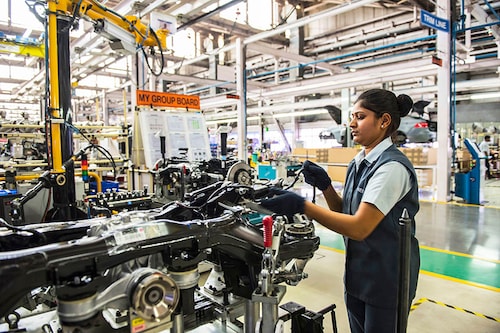How India's booming auto sector brought big gains for its parts suppliers
As vehicle sales grew to 21 million units from 17 million, the automotive component industry registered a growth of 32.8 percent over the previous year


It’s been a phenomenal year for India’s automakers. Vehicle sales in the world’s fourth-largest automobile market grew to a staggering 21 million units from about 17 million in the year-ago period, led by an exceptional growth in the country’s passenger vehicle segment. While that number still falls short of the 26 million the country recorded in 2020, a growth of 20 percent in the post-Covid era signals a return to normalcy in the sector. The sector is now expected to grow between seven and nine percent in the current fiscal.
India still lags many global economies when it comes to cars per capita, and a growing middle class in the world’s fastest-growing economy could possibly change that in the years to come. Various manufacturers ranging from Honda to Mercedes are now firming up launches in the country over the next few months, especially as the festive season starts.
That turnaround in the sector, one of the worst affected by Covid-19, meanwhile, has also brought significant gains for a sector that had long remained in the periphery—the country’s domestic auto component makers.
A push by the Indian government towards manufacturing within the country by offering incentives and supply constraints in China has meant that the country’s automotive component makers are having a field day. That’s only expected to continue in the years to come. Already, home-grown carmakers, ranging from Maruti to Tata and Mahindra, control as much as 65 percent of the market.
On August 7, the Automotive Component Manufacturers Association of India (ACMA), the apex body of the component manufacturing sector said the turnover of the automotive component industry stood at Rs 5.6 lakh crore ($69.7 billion) in fiscal year 2023, registering a growth of 32.8 percent over the previous year. This is the highest-ever turnover by the sector, eclipsing the Rs 4.20 lakh crore in FY 2022.
“On the front of trade, there has been steady growth in exports despite recessionary trends in Europe and the US, which are key export destinations for the auto components industry," says Sunjay Kapur, president, ACMA & chairman, Sona Comstar. “Strong rebound in vehicle sales in the domestic market also led to a sharper rise in imports that has translated into trade deficit this year."
Much of that increase was led by growth in value-added components and a shift in market preference towards larger and more powerful vehicles, according to the ACMA. ACMA represents over 800 auto component manufacturers in the country. On the export front, North America accounted for 32 percent of exports, with Europe accounting for 31 percent and Asia for 26 percent. The key export items included drive transmission and steering, engine components, body/chassis, suspension, and braking.
“With significant mitigation in the supply-side issues of availability of semiconductors, input raw-material costs, and logistics, the vehicle industry is expected to continue to perform well in FY24, which augurs well for the auto components sector," adds Kapur. “That apart, exports and growth in domestic aftermarket continue to be robust."
First Published: Aug 09, 2023, 14:43
Subscribe Now